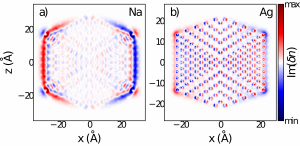PhD Thesis Defense- Marc barbry
Plasmons in Nanoparticles: Atomistic Ab Initio Theory for Large Systems
Candidate: Marc Barbry
Supervisors: Peter Koval and Daniel Sánchez-Portal
Research group: Modelisation and Simulation
When: 5th of July (11:00h)
Where: CFM Auditorium
Summary
In this thesis we have developed and improved a series of algorithms and numerical methods to compute the optical and plasmonic properties of nanostructures using time-dependent density functional theory (TDDFT). Our developments have been incorporated into the Many-body perturbation theory- linear combination of atomic orbitals (MBPT-LCAO) package. The MBPT-LCAO package is a tool to determine and analyze the electronic and optical properties of matter that has been developed by our research group and collaborators over the last decade.

Distribution of the imaginary part of induced density at resonance frequency for (a) sodium
and (b) silver icosahedral clusters containing 2869 atoms (10 atomic layers).
In the present work we have focused on improving the TDDFT part of the code by adding new functionalities such as the computation of electron energy loss spectroscopy (EELS) in response to arbitrary real-space trajectories of the probing electrons, improvements of the iterative procedure leading to large-scale atomistic ab initio calculations, and the computation of the induced electric field (near field) distribution around nanostructures. Using the newly implemented methods, we analyzed the properties of clusters of simple metals (sodium) and noble metals (silver) including up to five thousand atoms, and carbon and boron nitride nanotubes. These analyses have improved our knowledge of such systems with applications in nanooptics, as well as on the coupling between quantized electron transport and plasmonic properties in metal nanostructures.




